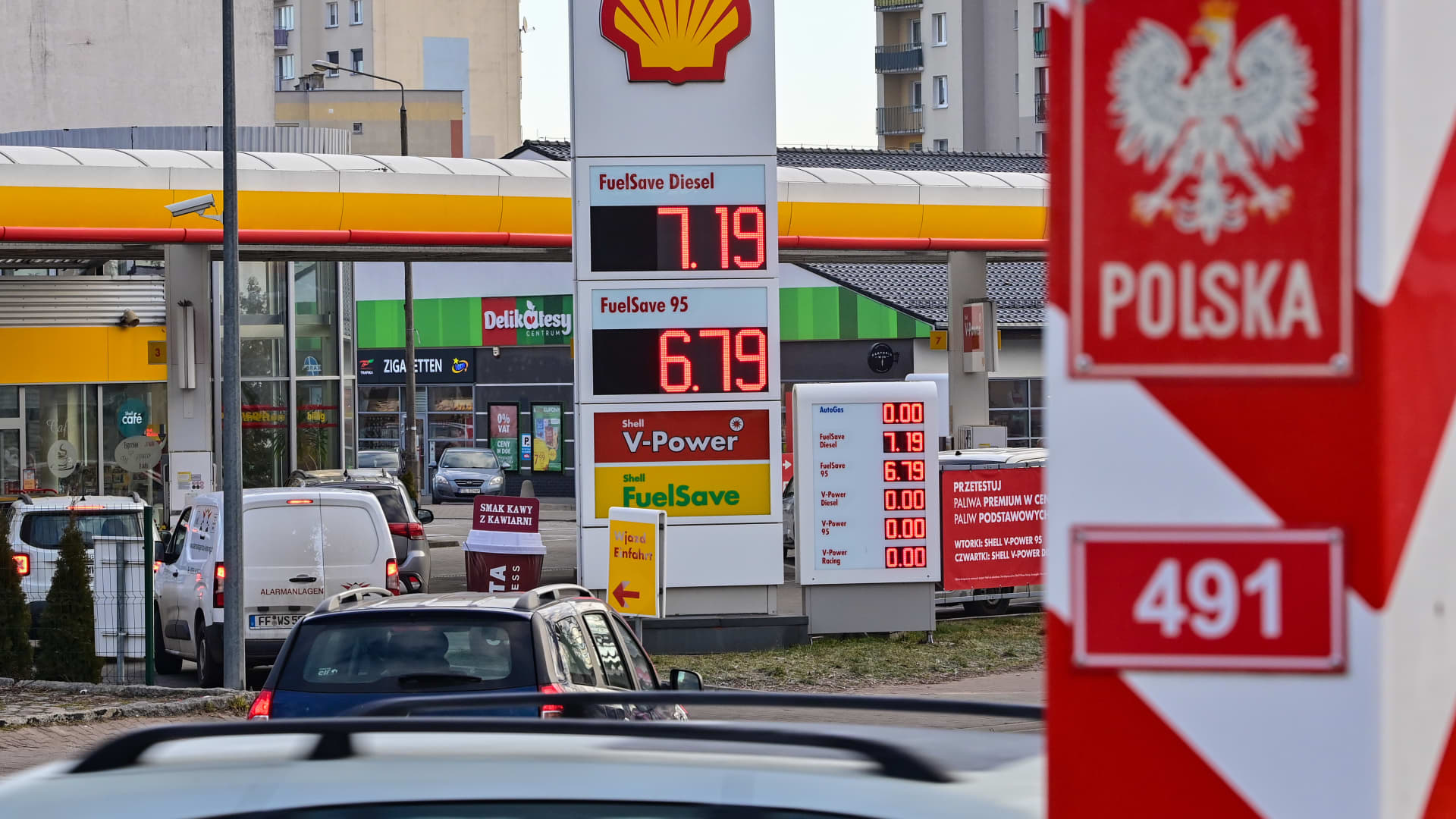
On a display at a gas station, a liter of diesel costs 7.19 zloty. Refueling is also more expensive than ever in Poland, but still a lot cheaper than in neighboring Germany.
Patrick Pleul | Picture Alliance | Getty Images
Poland’s economy has had a strong start to the year, but as the war in neighboring Ukraine enters its second month there are fears its growth could be about to get hit from multiple fronts.
Since Russia invaded Ukraine on Feb. 24 and triggered a raft of punitive international sanctions, the anticipated hit to exports, supply chain disruptions and rising inflation have threatened Eastern European economies in particular.
Poland is Europe’s sixth-largest economy by nominal GDP (without being adjusted for inflation) and a major producer of machinery, vehicles and electronics, as well as a host of minerals including coal, copper, zinc and rock salt.
The country’s economic performance in February — which does not capture the full impact of the conflict — was robust. Industrial output in the country grew by 17.6% year-on-year in February, and 2.1% in month-on-month seasonally-adjusted terms, after a 4.2% monthly rise in January. Production is now 24% above the level seen at the end of 2019.
Liam Peach, emerging markets economist at Capital Economics, noted last week that strength has been seen across the country’s export-oriented sectors, with manufacturing and electricity and gas production also on the up.
However, Peach said the war in Ukraine was casting a “dark cloud” over the country.
“Poland’s economy continued to expand strongly at the start of this year but the war in Ukraine is likely to drag on the recovery through a hit to exports, supply-chain disruptions and higher inflation,” he said.
“Poland’s goods exports to Russia amount to around 3% of GDP (these will more or less be lost) and imports from Russia (of mostly raw materials) will be severely disrupted, hitting Polish industry.”
Capital Economics has revised down its 2022 GDP growth forecast for Poland from 4.5% to 3.5% — below consensus expectations among economists — as the war in Ukraine shows no sign of abating.
‘Anti-inflation shields’
One particular cloud on Poland’s horizon is inflation. Along with much of Europe and beyond, Poland was battling persistently rising prices even before the conflict began.
The government in January temporarily cut value added tax on gas, food and gasoline in a bid to contain surging consumer prices, and headline inflation dropped to an annual 8.5% in February from 9.4% in January as a result.
However, the fresh geopolitical uncertainty and volatility in commodity markets further muddies inflation forecasts. In a note last week, JPMorgan said forecasts must be read with wide error bands, with strong underlying inflation pressures expected to persist in Poland over the next few months.
Capital Economics’ Peach highlighted that higher commodity prices in particular will push up food and energy inflation, squeezing real incomes and household spending.
“When the government’s tax cuts expire mid-year, energy prices are likely to rebound, pushing inflation toward the 12% area,” JPMorgan’s emerging Europe team said.
“However, we see a very good chance the government will extend the ‘anti-inflation shields,’ which would mean somewhat lower CPI.”
However, there is another upside risk to inflation in the country, according to the analysts: the European gas market. Gas prices hit an all-time high in Europe earlier this month.
Poland’s energy regulator in December approved a 54% increase in gas bills, and JPMorgan’s economists said further price hikes may be necessary.
The country has also welcomed swathes of refugees from Ukraine. More than 3.6 million people have so far fled the war, and more than half of these have crossed the border to Poland.
In a note at the beginning of March, Goldman Sachs suggested that the influx of refugees into the CEE-4 (Poland, Hungary, Slovakia and the Czech Republic) will provide a “material boost to GDP” that will offset the short-term hits to businesses and households from the conflict.
The economists lowered their GDP forecasts for the region by 0.25-0.5 percentage points in 2022, while raising them by a similar amount for 2023 as refugees begin to contribute to both domestic demand and the labor force.
The central bank dilemma
The National Bank of Poland now faces a difficult task, given relentless inflation pressures and new food and energy price shocks, which threaten to keep consumer prices high beyond the end of the year.
However this is combined with a fragile growth outlook which means the central bank can’t tighten policy as aggressively as it might usually do.
“In normal circumstances, the NBP could look through the supply shocks and focus on demand-pull pressures, but that leeway has been eroded in the last 24 months,” JPMorgan economists said
“At this stage, there is no downside to sounding hawkish: it supports the currency and can be reversed without losing credibility if, later on, the situation is not so bad.”
As a result, the economists believe the NBP will likely remain hawkish — favoring higher interest rates to keep inflation in check — though the timing and scale of future policy tightening moves remains uncertain, dependent on risk appetite in the foreign exchange market and demand dynamics.
“The zloty [Poland’s official currency] has rebounded from the lows, providing the NBP some room to maneuver. If demand side data weaken from March, that will strengthen the NBP’s ability to argue in the dovish direction,” JPMorgan said.
“Once that is factored in, and assuming no massive selloffs of the zloty, we think the NBP will aim for something like a peak policy rate of 5%, which we expect will be reached in 2Q22.”
The Polish central bank hiked its benchmark interest rate by 75 basis points to 3.5% on March 8, to its highest level for nine years. This was the sixth consecutive increase to the main policy rate.






